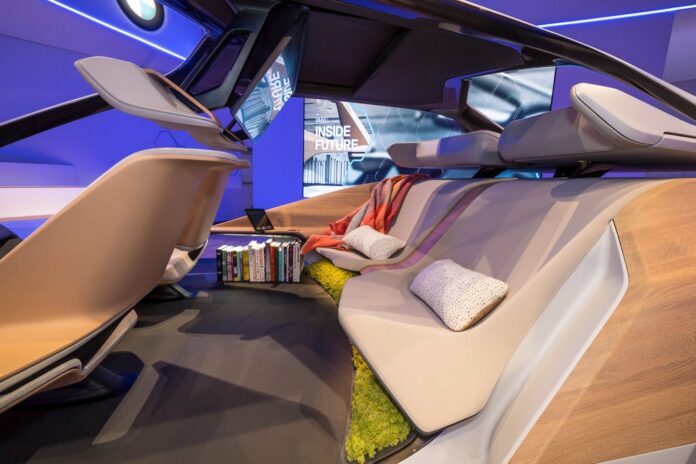As driverless car technology develops, companies, design institutes and researchers are asking the question: What does the car of the future look like on the inside? With car companies racing ahead to develop fully autonomous vehicles, the era of the driver hunched over the steering wheel may eventually give way to a living room on wheels. But with its long development lead times, designers are already thinking about how such technology will change the interiors of cars. When cars are fully autonomous, how we sit, inform and entertain ourselves will be up for grabs. If steering wheels are no longer needed, how do we best configure seating positions? What should be done with the space now occupied by a dashboard, once a vehicle handles all driving tasks and even decides when it needs to be serviced?
When cars are fully autonomous, how we sit, inform and entertain ourselves will be up for grabs. If steering wheels are no longer needed, how do we best configure seating positions? What should be done with the space now occupied by a dashboard, once a vehicle handles all driving tasks and even decides when it needs to be serviced?
Another group envisioned a vehicle’s interior as a constantly changing environment, using variable lighting and temperatures to fit the evolving moods and desires of each occupant, as determined through a sensor analysis of physiological and emotional states. A third proposal contemplated the use of virtual reality and motion-sensing seats to give occupants the feeling of driving a sports car, even when they were simply riding in a tame autonomous vehicle. Considering ideas like altering a vehicle’s internal lighting depending on its occupants’ moods or allowing a child passenger to initiate a search to find a nearby parking spot. Panasonic is also looking at using the windshield as an overlay for additional information or advertisements. The company declined to say how much it was spending on researching vehicle interiors, but said it was a “substantial” amount.
BMW is experimenting with keeping instruments at a low height. When necessary, the “driver” or responsible party would interact with controls through a holographic projection that would appear to hover closer to eye level in space, meaning they would not need to take their eyes off the road while adjusting the temperature or changing radio stations. While much is doable, should it be done? “On paper, it seems great that I can read email on my car’s window, but will we actually want it?” Mr. Kostepen of Panasonic said. “A car has to maintain its brand DNA even when it is fully autonomous.”
ANALYSIS:
This article does a great job of asking some really interesting questions about the future of autonomous vehicles and what that will mean for the interior of the car. As it asks these questions it also suggests some of the possible answers, proving that there are in fact very many options, paths and choices to look at. I find this to be a great article to help ask bold and thoughtful questions for this area of focus, as questions will lead to answers and solutions. However there was one part of this article that I wish was covered just a bit more, Kopstepen form Panasonic makes a great point that while we are offering all of these choices for consumers/users to customize and control more aspects of their vehicle, the brand may lose their identity. Obviously this is super important issue, and brands like their look to stand out and be noticed in hopes to spark interest from differing consumers. So because I actually hope that my design will give the user more customization to their vehicle, I will have to find a way to make sure Honda’s brand language can still be found and recognized amongst the wave of change.




